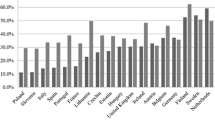Abstract
The problem of measuring the general level of trust in public institutions is addressed. A very general framework to compute an index of trust in public institutions is proposed and it is shown how to perform an uncertainty analysis of an index of trust to test its robustness. An application to data from the sixth round of the European Social Survey is presented. It is found that Scandinavian countries are the most trustful European countries in public institutions, whereas former communist countries as well as Iberian and Mediterranean ones are much less trustful. The governments of the least trustful countries in public institutions should be very careful in monitoring this issue and should think about introducing reforms to improve citizens’ trust. Improving trust in public institutions is central to improve social capital, participation in civic activities and law-abiding behavior and then governmental legitimacy.

Similar content being viewed by others
References
Algan, Y., & Cahuc, P. (2010). Inherited trust and growth. The American Economic Review, 100, 2060–2092.
Arboretti Giancristofaro, R., Pesarin, F., & Salmaso, L. (2007). Nonparametric approaches for multivariate testing with mixed variables and for ranking on ordered categorical variables with an application to the evaluation of PhD programs. In S. Sawilowsky (Ed.), Real Data Analysis (pp. 355–385). Charlotte, NC: Information Age Publishing.
Arboretti Giancristofaro, R., Bonnini, S., & Salmaso, L. (2009). Employment status and education/employment relationship of PhD graduates from the University of Ferrara. Journal of Applied Statistics, 36, 1329–1344.
Blanco, L. (2013). The impact of crime and insecurity on trust in democracy and institutions. The American Economic Review, 103, 284–288.
Bouckaert, G., Van de Walle, S., & Kampen, J. K. (2005). Potential for comparative public opinion research in public administration. International Review of Administrative Sciences, 71, 229–240.
Carlin, R. E. (2014). Whats not to trust? Rubrics of political party trustworthiness in Chile and Argentina. Party Politics, 20, 63–77.
Cook, T. E., & Gronke, P. (2005). The skeptical American: Revisiting the meanings of trust in government and confidence in institutions. Journal of Politics, 67, 784–803.
Cox, D. R., Fitzpatrick, R., Fletcher, A. E., Gore, S. M., Spiegelhalter, D. J., & Jones, D. R. (1992). Quality-of-life assessment: Can we keep it simple (with discussion)? Journal of the Royal Statistical Society Series A, 155, 353–393.
Downe, J., Cowell, R., Chen, A., & Morgan, K. (2013). The determinants of public trust in English local government: how important is the ethical behaviour of elected councillors? International Review of Administrative Sciences, 79, 597–617.
European Social Survey (2014). ESS Round 6 (2012/2013). Technical Report.
Fayers, P. M., & Hand, D. J. (2002). Causal variables, composite indicators and measurement scales: An example from quality of life. Journal of the Royal Statistical Society Series A, 165, 233–261.
Graeff, P., & Svendsen, G. T. (2013). Trust and corruption: The influence of positive and negative social capital on the economic development in the European Union. Quality and Quantity, 47, 2829–2846.
Hoskins, B. L., & Mascherini, M. (2009). Measuring active citizenship through the development of a composite indicator. Social Indicators Research, 90, 459–488.
Marozzi, M. (2009). A composite indicator dimension reduction procedure with application to university student satisfaction. Statistica Neerlandica, 63, 258–268.
Marozzi, M. (2012a). Tertiary student satisfaction with socialization: A statistical assessment. Quality and Quantity, 46, 1271–1278.
Marozzi, M. (2012b). Composite indicators: A sectorial perspective. In C. Perna & M. Sibillo (Eds.), Mathematical and statistical methods for actuarial sciences and finance (pp. 287–294). Milan: Springer.
Marozzi, M. (2014). Construction, dimension reduction and uncertainty analysis of an index of trust in public institutions. Quality and Quantity, 48, 939–953.
Michalek, J., & Zarnekow, N. (2012). Application of the rural development index to analysis of rural regions in Poland and Slovakia. Social Indicators Research, 105, 1–37.
Munda, G., Nardo, M., Saisana, M., & Srebotnjak, T. (2009). Measuring uncertainties in composite indicators of sustainability. International Journal of Environmental Technology and Management, 11, 7–26.
Munda, G., & Nardo, M. (2009). Noncompensatory/nonlinear composite indicators for ranking countries: A defensible setting. Applied Economics, 41, 1513–1523.
OECD (2008). Handbook on constructing composite indicators. Paris: OECD.
OECD (2011). Citizens as partners: OECD handbook of information, consultation and public participation in policy making. Paris: OECD.
Saisana, M., Saltelli, A., & Tarantola, S. (2005). Uncertainty and sensitivity analysis techniques as tools for the quality assessment of composite indicators. Journal of the Royal Statistical Society Series A, 168, 307–323.
Saisana, M., D’Hombres, B., & Saltelli, A. (2011). Rickety numbers: Volatility of university rankings and policy implications. Research Policy, 40, 165–177.
Saltelli, A. (2007). Composite indicators between analysis and advocacy. Social Indicators Research, 81, 65–77.
Saltelli, A., D’Hombres, B., Jesinghaus, J., Manca, A. R., Mascherini, M., & Nardo, M. (2011). Indicators for European Union policies. Business as usual? Social Indicators Research, 102, 197–207.
Shlapentokh, V. (2006). Trust in public institutions in Russia: the lowest in the world. Communist and Post-Communist Studies, 39, 153–174.
United Nations Development Programme (2013). Human development report. New York: UNDP.
Uslaner, E. M. (2013). Trust and corruption revisited: How and why trust and corruption shape each other. Quality and Quantity, 47, 3603–3608.
Zhou, P., & Ang, B. W. (2009). Comparing MCDA aggregation methods in constructing composite indicators using the Shannon–Spearman measure. Social Indicators Research, 94, 83–96.
Author information
Authors and Affiliations
Corresponding author
Rights and permissions
About this article
Cite this article
Marozzi, M. Measuring Trust in European Public Institutions. Soc Indic Res 123, 879–895 (2015). https://doi.org/10.1007/s11205-014-0765-9
Accepted:
Published:
Issue Date:
DOI: https://doi.org/10.1007/s11205-014-0765-9




